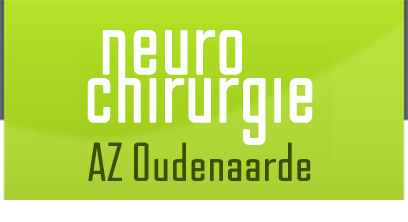Back pain & neck pain
Fractures of vertebrae and compression fractures caused by osteoporosis
Vertebral fractures have two main causes: accidents and osteoporosis (bone decalcification), which usually occurs at an advanced age.
Traumatic fractures or dislocation of vertebrae
Vertebrae can be damaged in different ways following an accident: fall from a height, sports accidents of cyclists or horsemen, etc.
Depending on the type of fracture, the neurosurgeon will suggest the most suited treatment option.

|
Fracture of 11th vertebra after a fall from a horse |
Less severe fractures can be repaired by kyphoplasty, a procedure in which semi-liquid ‘cement' is injected into the vertebra. This is done in the same way as for an osteoporotic compression fracture.

|

|
For more severe fractures, the use of screws and rods may be necessary to repair the fracture, whether or not in combination with kyphoplasty. These operations are carried out to the maximum extent possible using minimally invasive techniques to limit the pain after surgery and enhance the patient's recovery.
In such procedures, the insertion of screws and/or plates or the injection of cement is closely monitored by the O-arm. This innovative device allows to make very accurate CT-images during the actual operation.

|

|
|
Above: severe fracture of 12th thoracic vertebra. Recovery by way of balloon vertebroplasty and stabilisation with screws and rods. |
The same fracture during a radiographic examination 9 months after surgery: anatomical recovery of vertebra. The patient is now pain-free. |
Compression fractures caused by osteoporosis
At an advanced age, patients and especially women will often start suffering from osteoporosis (brittle bones). This may cause fractures, often after a trivial fall. Think of the many wrist or hip fractures. But the vertebrae can also suffer from osteoporosis as they may prolapse or become compressed. To repair these ‘osteoporotic compression fractures' of vertebrae, we usually apply balloon kyphoplasty or vertebroplasty (only injection with cement).
This is a surgical technique through which the vertebral fracture is repaired in a minimally invasive way by injecting a special type of 'cement'.
Description of the balloon vertebroplasty or kyphoplasty procedure
This procedure is carried out under general anaesthesia. Two cannulas (hollow tubes) are led into the broken vertebra along the back. This is done with extreme precision and care with continuous images being made during surgery with two radioscopic devices.
Through the hollow tubes, a balloon is led into the vertebra and inflated. This will ‘lift' the vertebra, creating a cavity. After having removed the balloons, this cavity is filled with semi-liquid cement. By creating the cavity in the vertebra and using semi-liquid cement, the cement will not start to leak and enter into the blood stream.

|

|
The cement will be fully hardened after a couple of hours and hardly twelve hours later the patient can get up.
The results in patients with prolapsed vertebrae are excellent: the pain is significantly less and further collapsing, which could otherwise lead to pronounced hunching of the back, is avoided.
Kyphoplasty and vertebroplasty are executed in very specific circumstances. Before surgery, we always make a financial arrangements with the patient because this treatment is not covered by the health insurance.
Video (opens new window)
